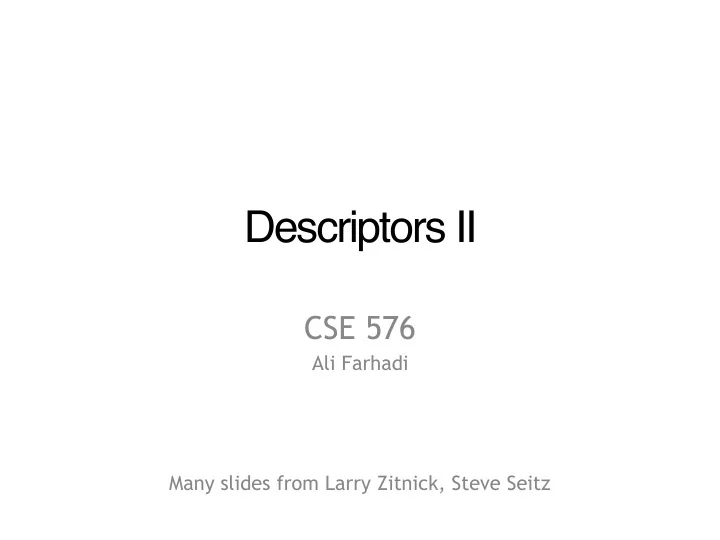

Descriptors II CSE 576 Ali Farhadi Many slides from Larry Zitnick, Steve Seitz
How can we find corresponding points?
How can we find correspondences?
SIFT descriptor Full version Divide the 16x16 window into a 4x4 grid of cells (2x2 case shown below) • Compute an orientation histogram for each cell • 16 cells * 8 orientations = 128 dimensional descriptor • Adapted from slide by David Lowe
Local Descriptors: Shape Context Count the number of points inside each bin, e.g.: Count = 4 ... Count = 10 Log-polar binning: more precision for nearby points, more flexibility for farther points. Belongie & Malik, ICCV 2001 K. Grauman, B. Leibe
Texture • Texture is characterized by the repetition of basic elements or textons • For stochastic textures, it is the identity of the textons, not their spatial arrangement, that matters Julesz, 1981; Cula & Dana, 2001; Leung & Malik 2001; Mori, Belongie & Malik, 2001; Schmid 2001; Varma & Zisserman, 2002, 2003; Lazebnik, Schmid & Ponce, 2003
Bag-of-words models • Orderless document representation: frequencies of words from a dictionary Salton & McGill (1983)
Bag-of-words models • Orderless document representation: frequencies of words from a dictionary Salton & McGill (1983) US Presidential Speeches Tag Cloud http://chir.ag/phernalia/preztags/
Bag-of-words models • Orderless document representation: frequencies of words from a dictionary Salton & McGill (1983) US Presidential Speeches Tag Cloud http://chir.ag/phernalia/preztags/
Bag-of-words models • Orderless document representation: frequencies of words from a dictionary Salton & McGill (1983) US Presidential Speeches Tag Cloud http://chir.ag/phernalia/preztags/
Bags of features for image classification 1. Extract features
Bags of features for image classification 1. Extract features 2. Learn “visual vocabulary”
Bags of features for image classification 1. Extract features 2. Learn “visual vocabulary” 3. Quantize features using visual vocabulary
Bags of features for image classification 1. Extract features 2. Learn “visual vocabulary” 3. Quantize features using visual vocabulary 4. Represent images by frequencies of “visual words”
Texture representation histogram Universal texton dictionary Julesz, 1981; Cula & Dana, 2001; Leung & Malik 2001; Mori, Belongie & Malik, 2001; Schmid 2001; Varma & Zisserman, 2002, 2003; Lazebnik, Schmid & Ponce, 2003
1. Feature extraction • Regular grid • Vogel & Schiele, 2003 • Fei-Fei & Perona, 2005 • Interest point detector • Csurka et al. 2004 • Fei-Fei & Perona, 2005 • Sivic et al. 2005
1. Feature extraction • Regular grid • Vogel & Schiele, 2003 • Fei-Fei & Perona, 2005 • Interest point detector • Csurka et al. 2004 • Fei-Fei & Perona, 2005 • Sivic et al. 2005 • Other methods • Random sampling (Vidal-Naquet & Ullman, 2002) • Segmentation-based patches (Barnard et al. 2003)
1. Feature extraction Compute Normalize SIFT patch descriptor [Lowe’99] Detect patches [Mikojaczyk and Schmid ’02] [Mata, Chum, Urban & Pajdla, ’02] [Sivic & Zisserman, ’03] Slide credit: Josef Sivic
1. Feature extraction …
2. Discovering the visual vocabulary …
2. Discovering the visual vocabulary … Clustering Slide credit: Josef Sivic
2. Discovering the visual vocabulary Visual vocabulary … Clustering Slide credit: Josef Sivic
Clustering and vector quantization • Clustering is a common method for learning a visual vocabulary or codebook • Unsupervised learning process • Each cluster center produced by k-means becomes a codevector • Codebook can be learned on separate training set • Provided the training set is sufficiently representative, the codebook will be “universal” • The codebook is used for quantizing features • A vector quantizer takes a feature vector and maps it to the index of the nearest codevector in a codebook • Codebook = visual vocabulary • Codevector = visual word
Example visual vocabulary Fei-Fei et al. 2005
Example codebook … Appearance codebook Source: B. Leibe
Another codebook … … … … … Appearance codebook Source: B. Leibe
Visual vocabularies: Issues • How to choose vocabulary size? • Too small: visual words not representative of all patches • Too large: quantization artifacts, overfitting • Computational efficiency • Vocabulary trees (Nister & Stewenius, 2006)
3. Image representation frequency ….. codewords
Image classification • Given the bag-of-features representations of images from different classes, learn a classifier using machine learning
Another Representation: Filter bank
Image from http://www.texasexplorer.com/austincap2.jpg Kristen Grauman
Showing magnitude of responses Kristen Grauman
Kristen Grauman
Kristen Grauman
Kristen Grauman
Kristen Grauman
Kristen Grauman
Kristen Grauman
Kristen Grauman
Kristen Grauman
Kristen Grauman
How can we represent texture? • Measure responses of various filters at different orientations and scales • Idea 1: Record simple statistics (e.g., mean, std.) of absolute filter responses
Can you match the texture to the response? Filters A B 1 2 C 3 Mean abs responses
Representing texture by mean abs response Filters Mean abs responses
Representing texture • Idea 2: take vectors of filter responses at each pixel and cluster them, then take histograms
Representing texture clustering
But what about layout? All of these images have the same color histogram
Spatial pyramid representation • Extension of a bag of features Locally orderless representation at several levels of resolution • level 0 Lazebnik, Schmid & Ponce (CVPR 2006)
Spatial pyramid representation Extension of a bag of features • Locally orderless representation at several levels of resolution • level 1 level 0 Lazebnik, Schmid & Ponce (CVPR 2006)
Spatial pyramid representation Extension of a bag of features • Locally orderless representation at several levels of resolution • level 1 level 2 level 0 Lazebnik, Schmid & Ponce (CVPR 2006)
What about Scenes?
Recommend
More recommend